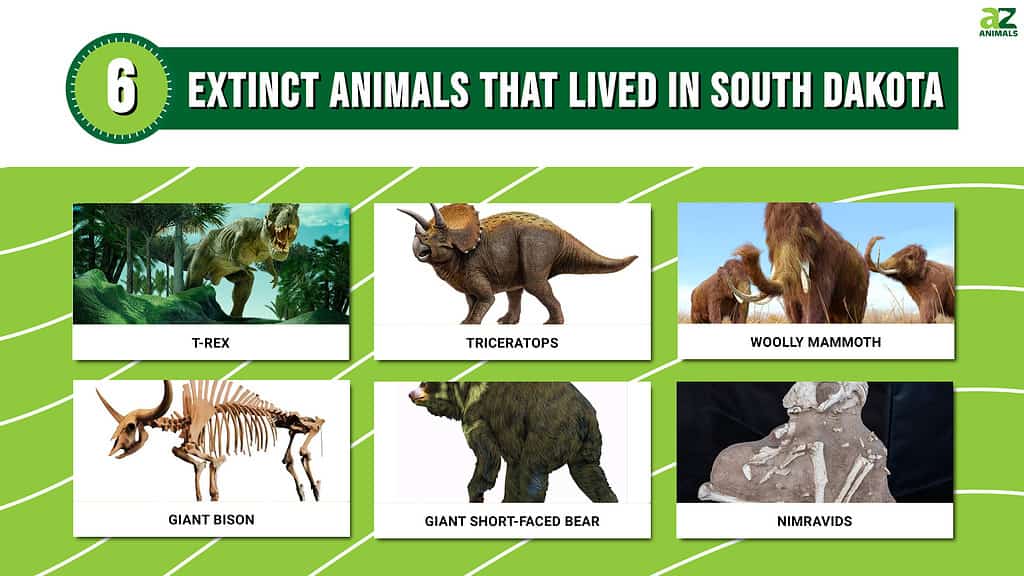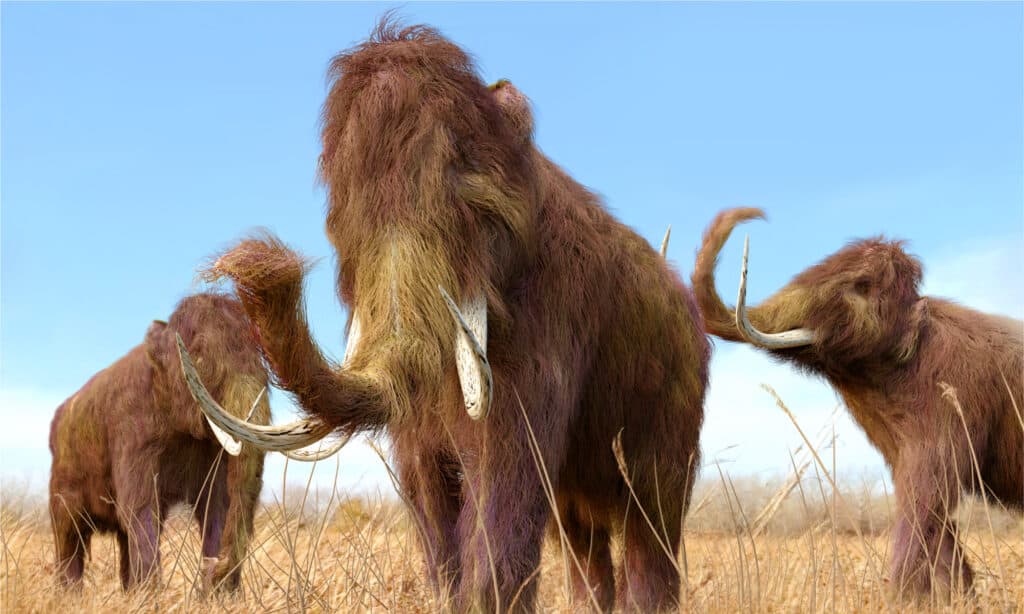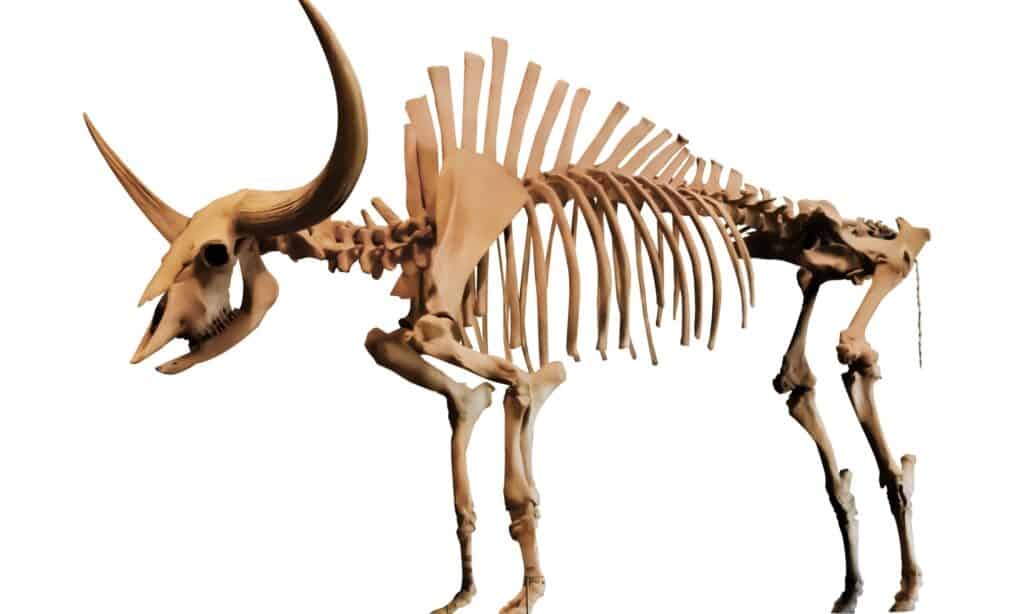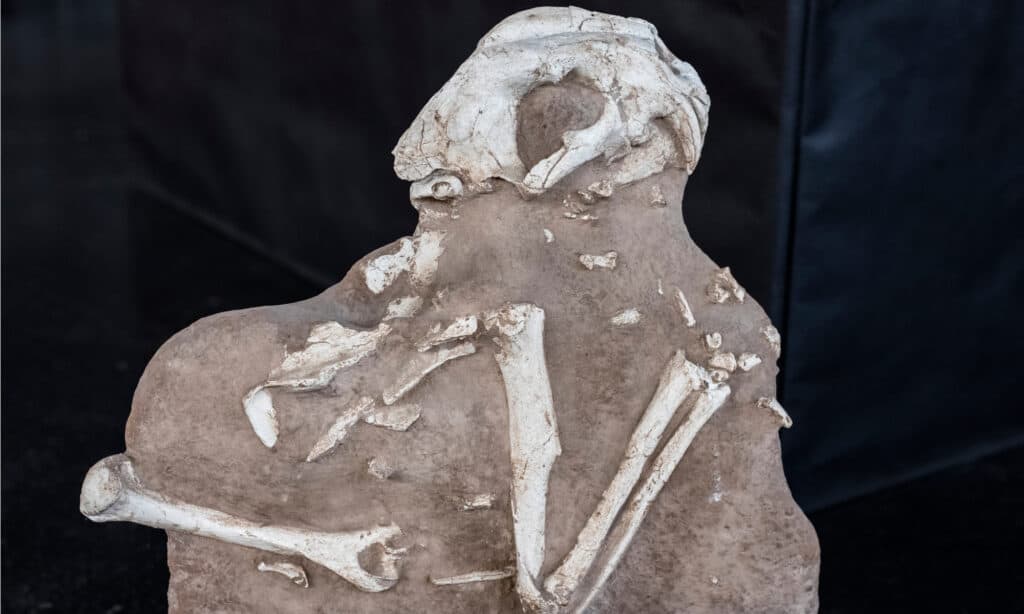South Dakota is home to approximately 244,000 acres of badlands. The early tribes that used to live here literally called it the badlands because a vast part of this region is well-known for its desert-like rock formations, lack of water that leads to limited vegetation, and a hot climate. Despite this, other parts of South Dakota are still richly covered in prairies, plains, caves, big lakes, swamps, rivers, and waterfalls.
According to research, ancient people first started to roam the lands of South Dakota over 12,000 years ago. The earliest American hunters used to chase ancient mammoths, camels, horses, and even large bison with spear points, one at a time. However, due to the advancement of their hunting tools, they started to change their hunting patterns and killed in large numbers rather than individually.
Today, we can only view these extinct animals in museums and excavation sites where their fossils were discovered. From dinosaurs to mammals, South Dakota is one of the richest spots to get a glimpse of the ancient world. Let’s find out more about the 6 extinct animals that used to live in South Dakota!

1. Tyrannosaurus Rex

The Tyrannosaurus Rex was a carnivore that remained at the top of the food chain in its territory.
©iStock.com/para827
| Tyrannosaurus Rex | |
|---|---|
| Kingdom | Animalia |
| Phylum | Chordata |
| Class | Reptilia |
| Order | Saurischia |
| Sub-Order | Theropoda |
| Family | Tyrannosauridae |
| Genus | Tyrannosaurus |
| Species | Tyrannosaurus Rex (other species in the latest studies are Tyrannosaurus Bataar, Tyrannosaurus Imperator, and Tyrannosaurus Regina) |
| Extinct since | 65 million years ago |
The Tyrannosaurus Rex, also known as T. Rex, is a carnivore that has remained at the top of the food chain in its territory, likely due to its large size and strength. They can weigh up to 18,000 pounds (9 tons) and can be as high as 12 to 13 feet off the ground. There are many theories why we no longer see a living T-Rex today. But most scientists believe a mass extinction happened millions of years ago when a meteor strike occurred, killing not just all Tyrannosaurus rex but also most species of dinosaurs walking on Earth.
Numerous fossil specimens have been recovered from the badlands of South Dakota and other parts of Montana. They are now under the care of several institutes. “Stan” is one particular specimen skeleton named after a paleontologist who discovered it in 1992. It was recently sold in an auction for $31.8 million. It has been replicated in casts all over the world. Another specimen skeleton discovered and excavated in South Dakota, “Sue,” was named after its discoverer, Sue Hendrickson.
2. Triceratops

Triceratops is believed to be the descendants of rhinoceros.
©Jean-Michel Girard/Shutterstock.com
| Triceratops | |
|---|---|
| Kingdom | Animalia |
| Phylum | Chordata |
| Class | Reptilia |
| Order | Ornithischia |
| Sub-Order | Ceratopsia |
| Family | Ceratopsidae |
| Genus | Triceratops |
| Species | T. horridus, T. prorsus |
| Extinct since | 66 million years ago |
One of the most famous dinosaurs from the Jurassic period is Triceratops. Their three-horned, strong skull is one of their most iconic features. They are herbivores with huge, bulky bodies, and are believed to be the descendants of rhinoceros.
3. Woolly Mammoths

Woolly mammoths are herbivores that feed on grass, twigs, and rushes.
©Aunt Spray/Shutterstock.com
| Woolly Mammoths | |
|---|---|
| Kingdom | Animalia |
| Phylum | Chordata |
| Class | Mammalia |
| Order | Proboscidea |
| Family | Elephantidae |
| Genus | Mammuthus |
| Species | Mammuthus primigenius |
| Extinct since | 37,000 years ago |
Woolly mammoths are herbivores that feed on grass, twigs, and rushes. They can grow up to 9.5 feet at the shoulder. Their tusks can grow up to 16 feet long. If they are not hunted, mammoths can live up to 60-80 years. They are the descendants of elephants.
South Dakota is not only rich in extinct reptiles, but it is also abundant in fossils of extinct mammals. In fact, the world’s largest concentration of mammoth fossils is found in the Mammoth Site of Hot Springs, South Dakota. Currently, 3 woolly mammoths and 58 Columbian mammoths are found on site.
4. Giant Bison

Giant bison are 25 to 50 percent larger than bison found in North America today.
©iStock.com/barbaraaaa
| Giant Bison | |
|---|---|
| Kingdom | Animalia |
| Phylum | Chordata |
| Class | Mammalia |
| Order | Artiodactyla |
| Family | Bovidae |
| Genus | Bison |
| Species | Bison latifrons |
| Extinct since | 20,000-30,000 years ago |
The Giant Bison, also known as Bison latifrons, is a species of bison that is already extinct today. Bison latifrons are 25 to 50 percent larger than bison found in North America today. When these species of giant herbivores died out thousands of years ago, the small ones took place. However, even the smaller modern ones are considered near threatened today.
5. Giant Short-Faced Bear

The giant short-faced bear is also known as Arctodus simus.
©iStock.com/CoreyFord
| Giant Short-Faced Bear | |
|---|---|
| Kingdom | Animalia |
| Phylum | Chordata |
| Class | Mammalia |
| Order | Carnivora |
| Family | Ursidae |
| Genus | Arctodus |
| Species | Arctodus simus |
| Extinct since | 12,000 years ago |
The Arctodus Simus, also known as the giant short-faced bear, was the largest mammalian carnivore during the Ice Age. These species belong to the family of bears, but their short snout makes them different from all of them, hence the name. Compared to the normal grizzly bears, Arctodus Simus had longer and more slender limbs, making them taller than modern bears. Because of their anatomy, scientists believed they were the fastest running bear. Additionally, one of the fossils found shows they have large dental dimensions, dentary proportions, and exceptionally short faces, revealing an exceedingly powerful bite from this individual, suggesting that they are carnivores.
6. Nimravids

Nimravids were hyper carnivorous.
©Art_rich/Shutterstock.com
| Nimravids | |
|---|---|
| Kingdom | Animalia |
| Phylum | Chordata |
| Class | Mammalia |
| Order | Carnivora |
| Family | Nimravidae |
| Genus | Hoplophoneus |
| Species | Hoplophoneus primaevus |
| Extinct since | 12,000 years ago |
Badlands National Park named Nimravids the Saber-toothed Hunters of the Badlands. Nimravids are hyper carnivorous, meaning they eat meat entirely for their whole diet. At first glance, it is easy for the Nimravidae family to be mistaken as part of the Felidae family, to which modern cats belong. Some scientists even named nimravids “pseudo-cats” or “false sabercats.” After all, they have large sharp teeth and are the same size as a lion or a jaguar. But there are distinctions in their skulls, middle ears, and the way they walk. Members of the Felidae family usually walk on their toes, while members of the Nimravidae family walk on their flat feet, much like a bear.
A 1959 paper described a skull found in the Badlands of South Dakota. It is nearly intact except for the right canine tooth pierced through another arm of a Nimravus. This injury may be from a fight between two pseudo-cats. On the other hand, it could be due to the weight of the overlying sediments.
The photo featured at the top of this post is © Dotted Yeti/Shutterstock.com
Thank you for reading! Have some feedback for us? Contact the AZ Animals editorial team.






